Abstract
Hybridoma cell lines that secrete monoclonal antiazophenylarsonate antibodies were isolated from the fusion of A/J splenic lymphocytes with a myeloma cell line. A small percentage of these hybridoma proteins were recognized by rabbit antisera that detect the crossreactive idiotype characteristics of the antiazophenylarsonate response of A/J mice. The isotype, pI value, and amino-terminal sequences of four independently derived idiotype-positive hybridoma proteins were determined. These proteins were either of the IgG1 or IgG2a heavy chain class. For two mice tested, the majority of the idiotype in the immune serum was shown to be of the same isotype as the fusion-derived monoclonal antibodies. The pI values of the hybridoma proteins differed from one another and ranged from 6.9 to 7.6. Amino acid sequences of the heavy chains showed a significant degree of homology with each other, but each chain was unique in the framework or the first complementarity determining region (or both). A comparable pattern of sequence variation was evident for the light chains. The azophenylarsonate idiotype, therefore, appears to consist of a family of nonidentical but closely related molecules that are the product of more than one germline gene or the result of somatic mutation of a single germline gene.
Full text
PDF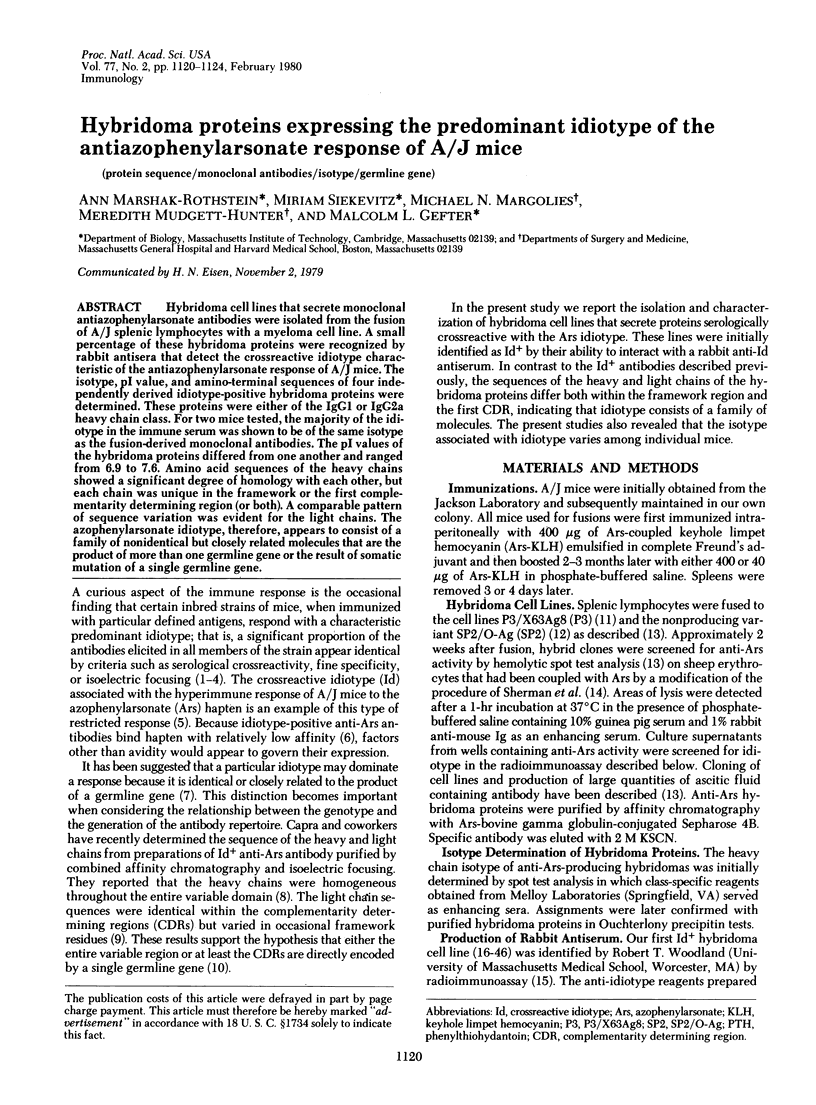
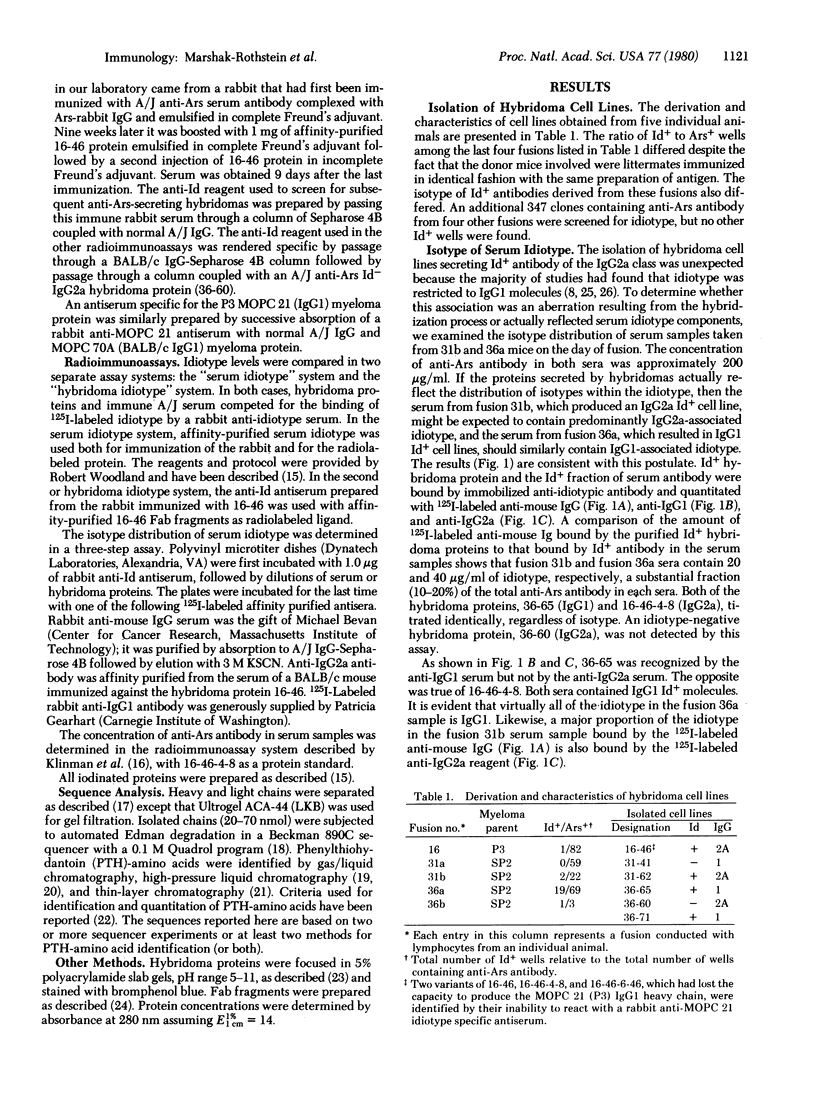
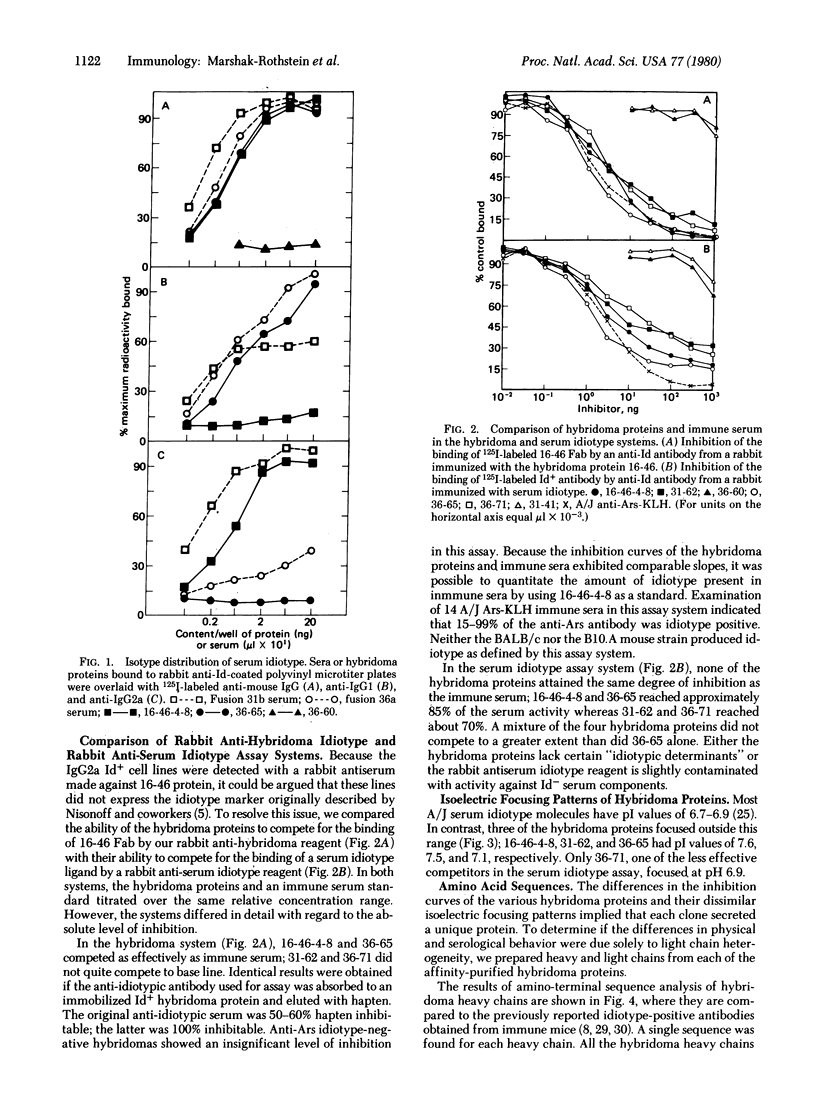
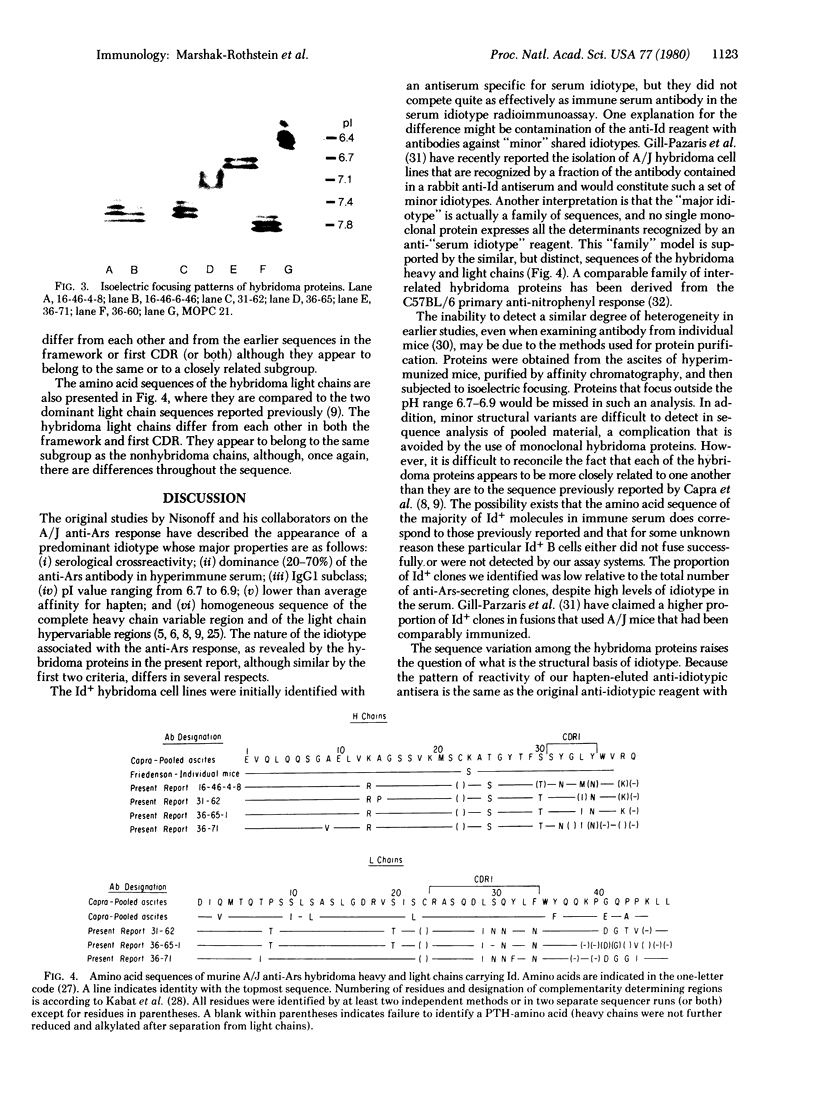
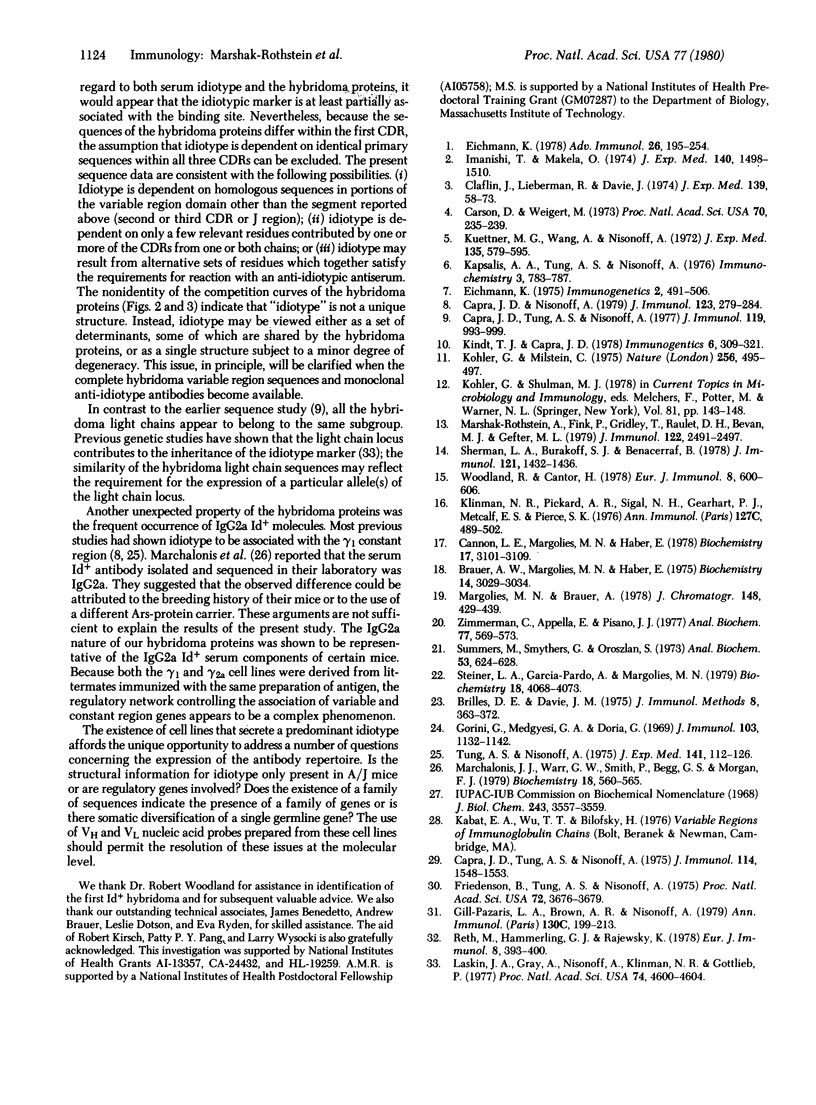
Images in this article
Selected References
These references are in PubMed. This may not be the complete list of references from this article.
- Brauer A. W., Margolies M. N., Haber E. The application of 0.1 M quadrol to the microsequence of proteins and the sequence of tryptic peptides. Biochemistry. 1975 Jul;14(13):3029–3035. doi: 10.1021/bi00684a036. [DOI] [PubMed] [Google Scholar]
- Briles D. E., Davie J. M. Detection of isoelectric focused antibody by autoradiography and hemolysis of antigen-coated erythrocytes. A comparison of methods. J Immunol Methods. 1975 Oct;8(4):363–372. doi: 10.1016/0022-1759(75)90058-7. [DOI] [PubMed] [Google Scholar]
- Cannon L. E., Margolies M. N., Haber E. Light chain variable region sequence of rabbit antipneumococcal type III polysaccharide antibody 3368. Biochemistry. 1978 Jul 25;17(15):3101–3109. doi: 10.1021/bi00608a025. [DOI] [PubMed] [Google Scholar]
- Capra J. D., Nisonoff A. Structural studies on induced antibodies with defined idiotypic specificities. VII. The complete amino acid sequence of the heavy chain variable region of anti-p-azophenylarsenate antibodies from A/J mice bearing a cross-reactive idiotype. J Immunol. 1979 Jul;123(1):279–284. [PubMed] [Google Scholar]
- Capra J. D., Tung A. S., Nisonoff A. Structural studies on induced antibodies with defined idiotypic specificities. I. The heavy chains of anti-p-azophenylarsonate antibodies from A/J mice bearing a cross-reactive idiotype. J Immunol. 1975 May;114(5):1548–1553. [PubMed] [Google Scholar]
- Capra J. D., Tung A. S., Nisonoff A. Structural studies on induced antibodies with defined idiotypic specificities. V. The complete amino acid sequence of the light chain variable regions of anti-p-azophenylarsonate antibodies from A/J mice bearing a cross-reactive idiotype. J Immunol. 1977 Sep;119(3):993–999. [PubMed] [Google Scholar]
- Carson D., Weigert M. Immunochemical analysis of the cross-reacting idiotypes of mouse myeloma proteins with anti-dextran activity and normal anti-dextran antibody. Proc Natl Acad Sci U S A. 1973 Jan;70(1):235–239. doi: 10.1073/pnas.70.1.235. [DOI] [PMC free article] [PubMed] [Google Scholar]
- Claflin J. L., Lieberman R., Davie J. M. Clonal nature of the immune response to phosphorylcholine. I. Specificity, class, and idiotype of phosphorylcholine-binding receptors on lymphoid cells. J Exp Med. 1974 Jan 1;139(1):58–73. doi: 10.1084/jem.139.1.58. [DOI] [PMC free article] [PubMed] [Google Scholar]
- Eichmann K. Expression and function of idiotypes of lymphocytes. Adv Immunol. 1978;26:195–254. doi: 10.1016/s0065-2776(08)60231-x. [DOI] [PubMed] [Google Scholar]
- Friedenson B., Tung A. S., Nisonoff A. Constancy of amino-terminal amino-acid sequences of antibodies of defined specificity and shared idiotype from individual inbred mice. Proc Natl Acad Sci U S A. 1975 Sep;72(9):3676–3679. doi: 10.1073/pnas.72.9.3676. [DOI] [PMC free article] [PubMed] [Google Scholar]
- Gill-Pazaris L. A., Brown A. R., Nisonoff A. In nature of idiotypes associated with anti-p-azophenylarsonate antibodies in A/J mice. Ann Immunol (Paris) 1979 Mar-Apr;130(2):199–213. [PubMed] [Google Scholar]
- Gorini G., Medgyesi G. A., Doria G. Heterogeneity of mouse myeloma gamma G globulins as revealed by enzymatic proteolysis. J Immunol. 1969 Nov;103(5):1132–1142. [PubMed] [Google Scholar]
- Imanishi T., Mäkelä O. Inheritance of antibody specificity. I. Anti-(4-hydroxy-3-nitrophenyl)acetyl of the mouse primary response. J Exp Med. 1974 Dec 1;140(6):1498–1510. doi: 10.1084/jem.140.6.1498. [DOI] [PMC free article] [PubMed] [Google Scholar]
- Kapsalis A. A., Tung A. S., Nisonoff A. Relative combining affinities of anti-p-azophenylarsonate antibodies bearing a cross-reactive idiotype. Immunochemistry. 1976 Sep;13(9):783–787. doi: 10.1016/0019-2791(76)90201-9. [DOI] [PubMed] [Google Scholar]
- Klinman N. R., Pickard A. R., Sigal N. H., Gearhart P. J., Metcalf E. S., Pierce S. K. Assessing B cell diversification by antigen receptor and precursor cell analysis. Ann Immunol (Paris) 1976 Jun-Jul;127(3-4):489–502. [PubMed] [Google Scholar]
- Kuettner M. G., Wang A. L., Nisonoff A. Quantitative investigations of idiotypic antibodies. VI. Idiotypic specificity as a potential genetic marker for the variable regions of mouse immunoglobulin polypeptide chains. J Exp Med. 1972 Mar 1;135(3):579–595. doi: 10.1084/jem.135.3.579. [DOI] [PMC free article] [PubMed] [Google Scholar]
- Köhler G., Milstein C. Continuous cultures of fused cells secreting antibody of predefined specificity. Nature. 1975 Aug 7;256(5517):495–497. doi: 10.1038/256495a0. [DOI] [PubMed] [Google Scholar]
- Laskin J. A., Gray A., Nisonoff A., Klinman N. R., Gottlieb P. D. Segregation at a locus determining an immunoglobulin genetic marker for the light chain variable region affects inheritance of expression of an idiotype. Proc Natl Acad Sci U S A. 1977 Oct;74(10):4600–4604. doi: 10.1073/pnas.74.10.4600. [DOI] [PMC free article] [PubMed] [Google Scholar]
- Marchalonis J. J., Warr G. W., Smith P., Begg G. S., Morgan F. J. Structural and antigenic studies of an idiotype-bearing murine antibody to the arsonate hapten. Biochemistry. 1979 Feb 20;18(4):560–565. doi: 10.1021/bi00571a002. [DOI] [PubMed] [Google Scholar]
- Marshak-Rothstein A., Fink P., Gridley T., Raulet D. H., Bevan M. J., Gefter M. L. Properties and applications of monoclonal antibodies directed against determinants of the Thy-1 locus. J Immunol. 1979 Jun;122(6):2491–2497. [PubMed] [Google Scholar]
- Reth M., Hämmerling G. J., Rajewsky K. Analysis of the repertoire of anti-NP antibodies in C57BL/6 mice by cell fusion. I. Characterization of antibody families in the primary and hyperimmune response. Eur J Immunol. 1978 Jun;8(6):393–400. doi: 10.1002/eji.1830080605. [DOI] [PubMed] [Google Scholar]
- Sherman L. A., Burakoff S. J., Benacerraf B. The induction of cytolytic T lymphocytes with specificity for p-azophenylarsonate coupled syngeneic cells. J Immunol. 1978 Oct;121(4):1432–1436. [PubMed] [Google Scholar]
- Steiner L. A., Pardo A. G., Margolies M. N. Amino acid sequence of the heavy-chain variable region of the crystallizable human myeloma protein Dob. Biochemistry. 1979 Sep 18;18(19):4068–4080. doi: 10.1021/bi00586a003. [DOI] [PubMed] [Google Scholar]
- Summers M. R., Smythers G. W., Oroszlan S. Thin-layer chromatography of sub-nanomole amounts of phenylthiohydantoin (PTH) amino acids on polyamide sheets. Anal Biochem. 1973 Jun;53(2):624–628. doi: 10.1016/0003-2697(73)90114-0. [DOI] [PubMed] [Google Scholar]
- Tung A. S., Nisonoff A. Isolation from individual A/J mice of anti-rho-azophenylarsonate antibodies bearing a cross-reactive idiotype. J Exp Med. 1975 Jan 1;141(1):112–126. doi: 10.1084/jem.141.1.112. [DOI] [PMC free article] [PubMed] [Google Scholar]
- Woodland R., Cantor H. Idiotype-specific T helper cells are required to induce idiotype-positive B memory cells to secrete antibody. Eur J Immunol. 1978 Aug;8(8):600–606. doi: 10.1002/eji.1830080812. [DOI] [PubMed] [Google Scholar]
- Zimmerman C. L., Appella E., Pisano J. J. Rapid analysis of amino acid phenylthiohydantoins by high-performance liquid chromatography. Anal Biochem. 1977 Feb;77(2):569–573. doi: 10.1016/0003-2697(77)90276-7. [DOI] [PubMed] [Google Scholar]



